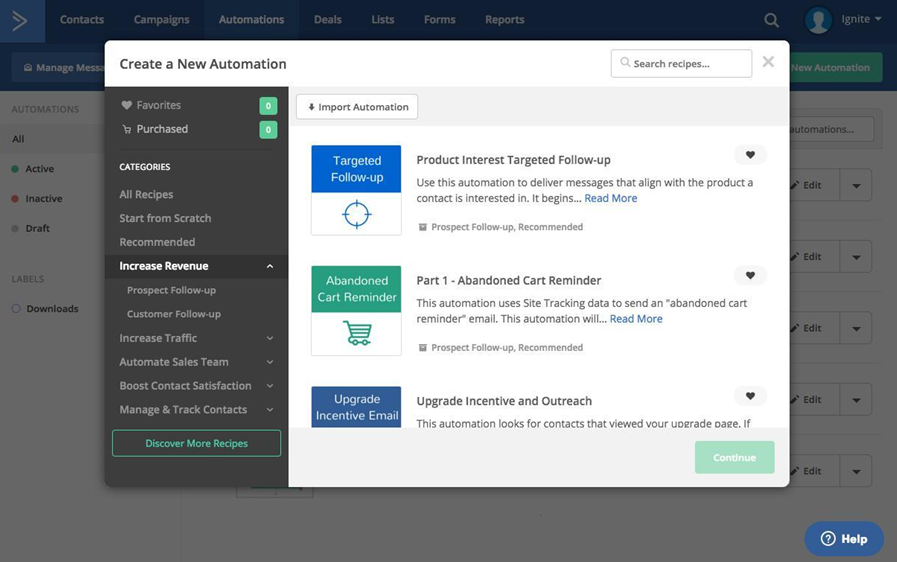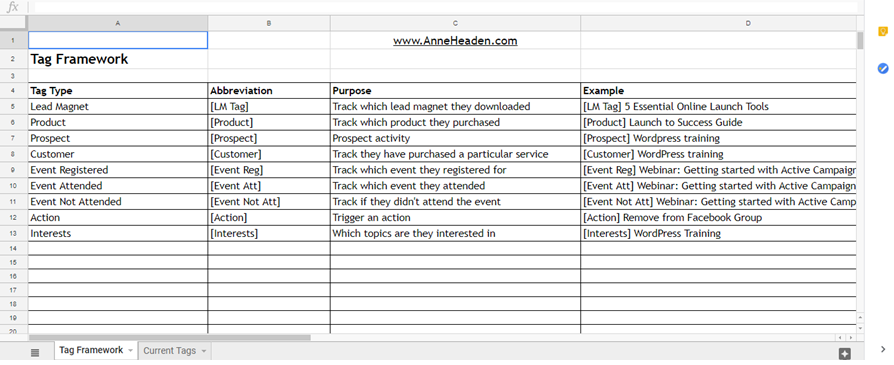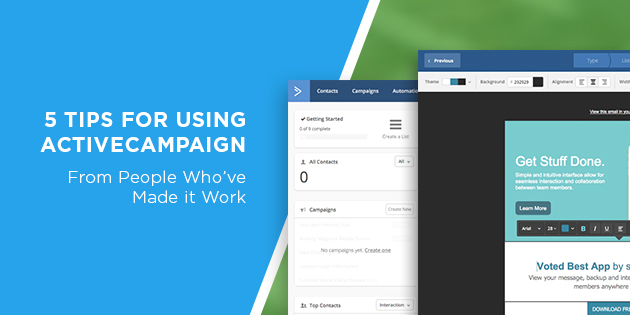5 Tips for Using ActiveCampaign (From People Who’ve Made It Work)
ActiveCampaign is much more than a basic marketing automation tool. People use it for everything from managing customers to helping with internal business processes. Here are five tips from people who make great use of the software
On the face of it, ActiveCampaign looks like little more than a marketing tool. And it’s certainly an effective one. You can use the software to create automated emailing and messaging campaigns. Marketers find these especially useful for sending emails to customers without having to spend a long time on the process.
If that was all it offered, there would be little to separate ActiveCampaign from other email automation platforms.
ActiveCampaign is much more versatile than you may give it credit for
You can use it for managing your customer’s journeys and building your sales funnels. It’s also useful for internal processes, such as recruitment, onboarding, and project management.
The question you have now is “how?”
How can you get more out of ActiveCampaign so that you’re using the platform to the fullest?
This article looks at some of the things that others use the platform to achieve. You may find some insight into how you can make better use of ActiveCampaign thanks to their advice.
Julian Juenemann – Personalise Website Content Using ActiveCampaign Data
MeasureSchool is an educational organisation that focuses on how you can use data more effectively. Its founder, Julian, says that you can pull customer data out of ActiveCampaign to personalise website content for users.
He does this pulling data from ActiveCampaign and into the Google Tag Manager. The key here is that he creates a method of communication between these two tools. You may use ActiveCampaign as a Customer Relationship Management (CRM) platform. But you aren’t leveraging this data to help in other areas.

Figure 1 – https://www.youtube.com/watch?v=4YgPL8zWtds
With Julian’s technique, you integrate your customer data into the data layer of Google Tag Manager. This allows you to personalise the content delivered to website users. For example, you may have a customer who’s logged into your website. This technique allows you to use that customer’s data to deliver messages that use the customer’s name. It can even dig deeper and auto-fill forms on your website based on the customer’s information.
The end result is a deeper connection with the customer that also offers more convenience.
This is a pretty advanced use case and not something we’d typically recommend but if you’re interested Julian goes into more detail about how to put this into practice here.

Create Automations Within Automations
It’s likely that you’re not taking full advantage of the automation tools within ActiveCampaign. You may have an automated mailing setup. But you’re not digging deeper to create automations within those automations.
We can show you how to do this.
Assume that you want to send an email that informs a customer about multiple products. You may have blue, red, and green shoes on offer.
That’s part of your regular automated process. You can then create automations within this automation for each of your products. For example, let’s say that the recipient clicks on a link for the blue shoes. You can use ActiveCampaign to switch them onto a different automated email round that’s focused on those blue shoes. This could trigger the sending of more informational emails and offers to try to secure the purchase.

Figure 2 – https://igniteonline.com.au/blog/activecampaign-pro-tips-to-engage-your-customers-and-drive-sales/
The aim is to create a branching structure. In this structure, you have an overarching automation that has several other automated paths diverging from it. This structure allows you to deliver more relevant content based on the actions the recipient takes. It also means you save even more time that you might have spent chasing specific leads.
Anne Headen – Map Out Your Tag Structures
You already know that you can use tags to determine where your messages go.
Anne Headen, who’s a virtual support professional, recommends taking some time to set things up before you start tagging. She says that just jumping straight into tagging can actually cost you time later on. Remember your goal is to set up an automation that doesn’t require constant revisiting. Confused tagging prevents that from happening.
Anne created a pair of spreadsheets to help her plan ahead. The first mapped out the various tag types she’d use and their purposes. The second mapped out the various tags based on what they do and which tag type they belong to.

Figure 3 – https://docs.google.com/spreadsheets/d/1lc_Yu0H1SjxD8ssFu5AhSMh3o8IeiaTX2QBnA6MgSSA/edit#gid=0
She then shared this with everybody in her organisation so that they’re all on the same page.
This mapping process took place outside of ActiveCampaign and took a little time to complete. But with the structure in place, her organisation now uses tagging much more effectively.
You can view Anne’s spreadsheet here.

Justin Brooke – Create a Lead Scoring System
An automated email campaign may pull leads towards your business. But then you have to spend time categorising them to figure out how to push them through your sales funnel.
Justin Brooke of IMScalable has a great solution that leads to you spending less time working through data in ActiveCampaign.
He recommends creating an automation that kicks in whenever somebody subscribes to any of your lists. For example, someone who subscribes to your newsletter would land in this list.
The key here is that you’re using lead scoring to determine the actions you take with the lead. You’re already automating the sending of whatever they subscribed to. This next step allows you to figure out what to do next.
He says that this overriding automation should sit on the customer for 30 days. During that 30-day period, you use lead scoring to track the customer’s actions. He assigns five points to anyone who opens an email and a further 10 to those who click links.

Figure 4 – https://d226aj4ao1t61q.cloudfront.net/ahaqsjbj_change-lead-score-points.png
At the end of the 30 days, you total the scores up.
Those who score 50 or above go into a VIP automation. Those who score less than 50 go into a standard customer automation. And those who score 0 go into an “Inactive” automation.
Each of these automations then handles the follow-up for that lead based on their interactions with your content.
This is essentially a spin on Ignite Online’s automations within automations ideas. What it does is allow you to spend less time chasing leads based on the actions they’ve taken. That means less time spent in ActiveCampaign and more time spent on actually selling.
Jordan Skole – Use Deal Pipelines to Handle Recruitment
Jordan Skole of Ventures & Adventures uses Deal Pipelines to great effect in ActiveCampaign.
He doesn’t just focus on customer-centric pipelines either. Jordan also creates deals for recruitment.
He uses ActiveCampaign to log the details of each applicant that a job posting receives. He then uses an automation to create a deal that triggers when he receives an application.
This automation has six stages:
- Application Received. The automation notes the receipt of an application and tags it with the source. Jordan can then use this to see which source produces great applicants.
- Application Screened. The automation logs when the screening process ends for the application.
- Phone Screened. A phone conversation has taken place. This stage logs the results of that conversation, with successful screenings leading to the next step.
- Interviewed. An in-person interview takes place. Again, the automation logs the outcome.
- Offer Made. Jordan submits an offer to the applicant. This can take the form of an email sent via ActiveCampaign.
- Offer Accepted. The candidate accepts the offer and becomes part of the team.
This automation allows Jordan to track the recruitment process so he can shore up inefficiencies. For example, it may show him that a recruitment source isn’t as effective as its price suggests.
He can also use deals to handle the onboarding process and other aspects of employee relations.
The Final Word
Some of these ActiveCampaign users show that you can use the software for more than basic marketing campaigns. Others highlight clever tricks that you can use to make your use of the software more efficient. After all, you’re using ActiveCampaign to save time. That means you don’t want to spend all day in the software.
Using these tips, you can use the data that the platform collects more effectively.
You can also download our Outsourced Task Ideas for ActiveCampaign Users whitepaper to get even more tips.
And if you haven’t started using ActiveCampaign yet, you can head directly to the ActiveCampaign website to purchase the platform for yourself. The site also contains plenty of additional insights into how you can use the software more effectively.
Or, maybe you’re not working with us just yet and don’t know if we’re right for you. Chat to our Facebook Messenger chatbot to see if we can help you.


